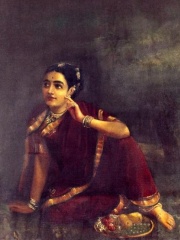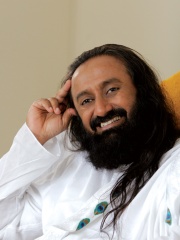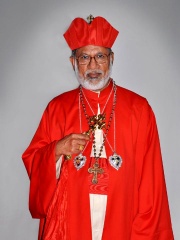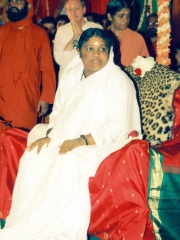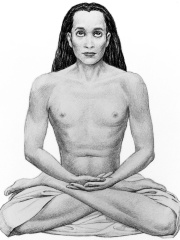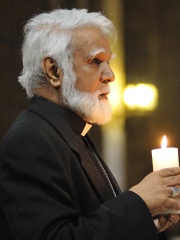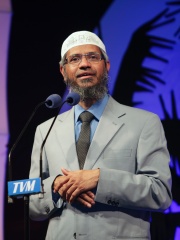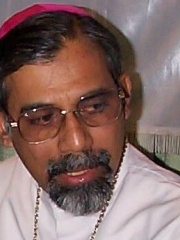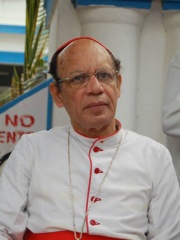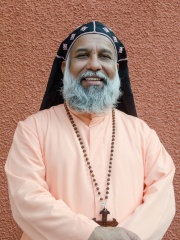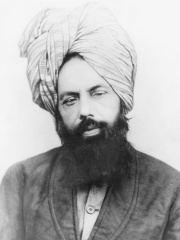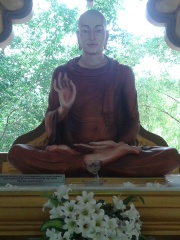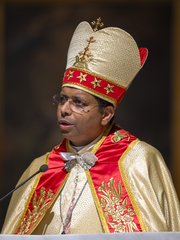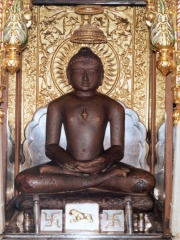

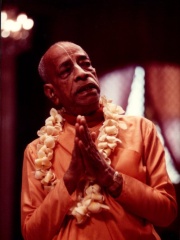

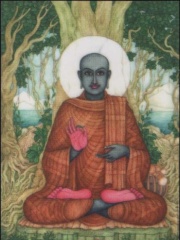
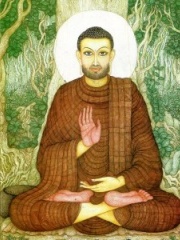
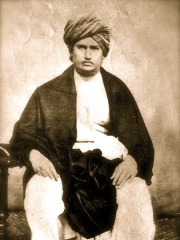
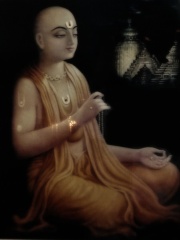
The Most Famous
RELIGIOUS FIGURES from India
This page contains a list of the greatest Indian Religious Figures. The pantheon dataset contains 3,187 Religious Figures, 64 of which were born in India. This makes India the birth place of the 10th most number of Religious Figures behind Saudi Arabia, and Egypt.
Top 10
The following people are considered by Pantheon to be the top 10 most legendary Indian Religious Figures of all time. This list of famous Indian Religious Figures is sorted by HPI (Historical Popularity Index), a metric that aggregates information on a biography's online popularity. Visit the rankings page to view the entire list of Indian Religious Figures.

1. Mahavira (599 BC - 527 BC)
With an HPI of 81.77, Mahavira is the most famous Indian Religious Figure. His biography has been translated into 78 different languages on wikipedia.
Mahavira (Mahāvīra), also known by his birth name Vardhamana (Vardhamāna), was an Indian religious reformer and spiritual leader who is considered by Jains to be the 24th and final Tirthankara (Supreme Preacher) of this age in Jainism. He is believed by historians to have lived in the 6th or 5th century BCE, reviving and reforming an earlier Jain or proto-Jain community which had likely been led by Pārśvanātha, whom Jains consider to be Mahavira's predecessor. Although the dates of Mahavira's life are uncertain and historically reliable information is scarce, and traditional accounts vary by sectarian traditions, the historicity of Mahavira is well-established and not in dispute among scholars. According to traditional legends and hagiographies, Mahavira was born in 599 BCE to a ruling royal kshatriya Jain family of the Nāya tribe in what is now Bihar in India. According to traditional sources like the Ācārāṅga Sūtra, the Nāyas were followers of Parshvanatha, Mahavira's predecessor. Mahavira abandoned all worldly possessions at the age of about 30 and left home in pursuit of spiritual awakening, becoming an ascetic. Mahavira practiced intense meditation and severe austerities for twelve and a half years, after which he attained Kevala Jnana (omniscience). He preached for 30 years and attained moksha (liberation) when he died. Mahavira taught attainment of samyak darshan or self realization (atma-anubhuti) through the practice of bhedvijnāna, which involves positioning oneself as a pure soul, separate from body, mind and emotions, and being aware of the soul's true nature; and to remain grounded and steadfast in soul's unchanging essence during varying auspicious or inauspicious external circumstances. He also preached that the observance of the vows of ahimsa (non-violence), satya (truth), asteya (non-stealing), brahmacharya (chastity), and aparigraha (non-attachment) are necessary for spiritual liberation. He taught the principles of Anekantavada (many-sided reality): syadvada and nayavada. Mahavira's teachings were compiled by Indrabhuti Gautama (his chief disciple) as the Jain Agamas. The texts, transmitted orally by Jain monks, are believed to have been largely lost by about the 1st century CE. Mahavira is usually depicted in a sitting or standing meditative posture, with the symbol of a lion beneath him. His earliest iconography is from archaeological sites in the North Indian city of Mathura, and is dated from between the 1st century BCE and the 2nd century CE. His birth is celebrated as Mahavira Janma Kalyanaka while his nirvana (liberation) and attainment of Kevala jnana (omniscience) by Gautama Swami are observed by Jains as Diwali.

2. Ānanda (600 BC - 500 BC)
With an HPI of 78.77, Ānanda is the 2nd most famous Indian Religious Figure. His biography has been translated into 50 different languages.
Ānanda (Pali and Sanskrit: आनंद; 5th–4th century BCE) was the primary attendant of the Buddha and one of his ten principal disciples. Among the Buddha's many disciples, Ānanda stood out for having the best memory. Most of the texts of the early Buddhist Sutta-Piṭaka (Pali: सुत्त पिटक; Sanskrit: सूत्र-पिटक, Sūtra-Piṭaka) are attributed to his recollection of the Buddha's teachings during the First Buddhist Council. For that reason, he is known as the Treasurer of the Dhamma, with Dhamma (Sanskrit: धर्म, dharma) referring to the Buddha's teaching. In Early Buddhist Texts, Ānanda was the first cousin of the Buddha. Although the early texts do not agree on many parts of Ānanda's early life, they do agree that Ānanda was ordained as a monk and that Puṇṇa Mantānīputta (Sanskrit: पूर्ण मैत्रायणीपुत्र, Pūrṇa Maitrāyaṇīputra) became his teacher. Twenty years in the Buddha's ministry, Ānanda became the attendant of the Buddha, when the Buddha selected him for this task. Ānanda performed his duties with great devotion and care, and acted as an intermediary between the Buddha and the laypeople, as well as the saṅgha (Sanskrit: संघ, romanized: saṃgha, lit. 'monastic community'). He accompanied the Buddha for the rest of his life, acting not only as an assistant, but also as a secretary and a mouthpiece. Scholars are skeptical about the historicity of many events in Ānanda's life, especially the First Council, and consensus about this has yet to be established. A traditional account can be drawn from early texts, commentaries, and post-canonical chronicles. Ānanda had an important role in establishing the order of bhikkhunīs (Sanskrit: भिक्षुणी, romanized: bhikṣuṇī, lit. 'female mendicant'), when he requested the Buddha on behalf of the latter's foster-mother Mahāpajāpati Gotamī (Sanskrit: महाप्रजापती गौतमी, Mahāprajāpatī Gautamī) to allow her to be ordained. Ānanda also accompanied the Buddha in the last year of his life, and therefore was witness to many tenets and principles that the Buddha conveyed before his death, including the well-known principle that the Buddhist community should take his teaching and discipline as their refuge, and that he would not appoint a new leader. The final period of the Buddha's life also shows that Ānanda was very much attached to the Buddha's person, and he saw the Buddha's passing with great sorrow. Shortly after the Buddha's death, the First Council was convened, and Ānanda managed to attain enlightenment just before the council started, which was a requirement. He had a historical role during the council as the living memory of the Buddha, reciting many of the Buddha's discourses and checking them for accuracy. During the same council, however, he was chastised by Mahākassapa (Sanskrit: महाकाश्यप, Mahākāśyapa) and the rest of the saṅgha for allowing women to be ordained and failing to understand or respect the Buddha at several crucial moments. Ānanda continued to teach until the end of his life, passing on his spiritual heritage to his pupils Sāṇavāsī (Sanskrit: शाणकवासी, Śāṇakavāsī) and Majjhantika (Sanskrit: मध्यान्तिक, Madhyāntika), among others, who later assumed leading roles in the Second and Third Councils. Ānanda died 20 years after the Buddha, and stūpas (monuments) were erected at the river where he died. Ānanda is one of the most loved figures in Buddhism. He was widely known for his memory, erudition and compassion, and was often praised by the Buddha for these matters. He functioned as a foil to the Buddha, however, in that he still had worldly attachments and was not yet enlightened, as opposed to the Buddha. In the Sanskrit textual traditions, Ānanda is considered the patriarch of the Dhamma who stood in a spiritual lineage, receiving the teaching from Mahākassapa and passing them on to his own pupils. Ānanda has been honored by bhikkhunīs since early medieval times for his merits in establishing the nun's order. In recent times, the composer Richard Wagner and Indian poet Rabindranath Tagore were inspired by stories about Ānanda in their work.

3. A. C. Bhaktivedanta Swami Prabhupada (1896 - 1977)
With an HPI of 77.86, A. C. Bhaktivedanta Swami Prabhupada is the 3rd most famous Indian Religious Figure. His biography has been translated into 64 different languages.
Abhay Charanaravinda Bhaktivedanta Swami Prabhupada (IAST: Abhaya Caraṇāravinda Bhaktivedānta Svāmī Prabhupāda; Bengali: অভয় চরণারবিন্দ ভক্তিবেদান্ত স্বামী প্রভুপাদ; 1 September 1896 – 14 November 1977) was a spiritual, philosophical, and religious teacher from India who spread the Hare Krishna mantra and the teachings of "Krishna consciousness" to the world. Born as Abhay Charan De and later legally named Abhay Charanaravinda Bhaktivedanta Swami, he is often referred to as "Bhaktivedanta Swami", "Srila Prabhupada", or simply "Prabhupada". To carry out an order received in his youth from his spiritual teacher to spread "Krishna consciousness" in English, he journeyed from Kolkata to New York City in 1965 at the age of 69, on a cargo ship with little more than a few trunks of books. He knew no one in America, but he chanted Hare Krishna in a park in New York City, gave classes, and in 1966, with the help of some early students, established the International Society for Krishna Consciousness (ISKCON), which now has centers around the world. He taught a path in which one aims at realizing oneself to be an eternal spiritual being, distinct from one's temporary material body, and seeks to revive one's dormant relationship with the supreme living being, known by the Sanskrit name Krishna. One does this through various practices, especially through hearing about Krishna from standard texts, chanting mantras consisting of names of Krishna, and adopting a life of devotional service to Krishna. As part of these practices, Prabhupada required that his initiated students strictly refrain from non-vegetarian food (such as meat, fish, or eggs), gambling, intoxicants (including coffee, tea, or cigarettes), and extramarital sex. In contrast to earlier Indian teachers who promoted the idea of an impersonal ultimate truth in the West, he taught that the Absolute is ultimately personal. He held that the duty of a guru was to convey intact the message of Krishna as found in core spiritual texts such as the Bhagavad Gita. To this end, he wrote and published a translation and commentary called Bhagavad-Gītā As It Is. He also wrote and published translations and commentaries for texts celebrated in India but hardly known elsewhere, such as the Srimad-Bhagavatam (Bhagavata Purana) and the Chaitanya Charitamrita, thereby making these texts accessible in English for the first time. In all, he wrote more than eighty books. In the late 1970s and the 1980s, ISKCON came to be labeled a destructive cult by critics in America and some European countries. Although scholars and courts rejected claims of cultic brainwashing and recognized ISKCON as representing an authentic branch of Hinduism, the "cult" label and image have persisted in some places. Some of Prabhupada's views or statements have been perceived as racist towards Black people, discriminatory against lower castes, or misogynistic. Decades after his death, Prabhupada's teachings and the Society he established continue to be influential, with some scholars and Indian political leaders calling him one of the most successful propagators of Hinduism abroad.

4. Sathya Sai Baba (1926 - 2011)
With an HPI of 75.23, Sathya Sai Baba is the 4th most famous Indian Religious Figure. His biography has been translated into 58 different languages.
Sathya Sai Baba (born Ratnakaram Sathyanarayana Raju; 23 November 1926 – 24 April 2011) was an Indian godman and philanthropist. At the age of 14, he claimed to be the reincarnation of Shirdi Sai Baba and left his home saying "My devotees are calling me, I have my work". Sathya Sai Baba's followers have attributed to him a range of miraculous abilities, including the materialisation of Vibhuti (holy ash) and other small objects such as rings, necklaces, and watches. He was also believed to have performed spontaneous healings, resurrections, and exhibited clairvoyant abilities. Additionally, claims were made regarding his ability to be in multiple places simultaneously (bilocation), as well as his omnipresence, omnipotence, and omniscience. Sathya Sai Baba's devotees include members of all religions. In 1972, Sathya Sai Baba founded the Sri Sathya Sai Central Trust. Through this organization, Sathya Sai Baba established a network of free, general, and superspeciality hospitals, medical clinics, drinking water projects, educational institutions, ashrams, and auditoriums. Sathya Sai Baba faced numerous accusations over the years which include sleight of hand, sexual abuse, money laundering, fraud, and murder. However, he was never charged with any offence, and his devotees strongly reject these accusations, considering them propaganda against their guru. By virtue of his sizeable influence, many feel Sai Baba provides an example of "the phenomenon referred to as mahagurus; that is, gurus with a global reach." Citing the number of Sai Centres (over 2000 in 137 countries), the scope of service and charitable works (free hospitals, drinking water projects), social sphere and influence of devotees (royalty, celebrities, high ranking politicians along with a total number of devotees estimated to be from 6 to 100 million worldwide) as well as being seen as a global "movement extending in some very surprising ways."
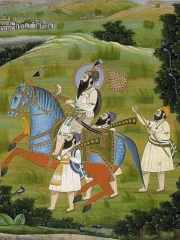
5. Guru Gobind Singh (1666 - 1708)
With an HPI of 73.68, Guru Gobind Singh is the 5th most famous Indian Religious Figure. His biography has been translated into 61 different languages.
Guru Gobind Singh (Punjabi pronunciation: [gʊɾuː goːbɪn̪d̪ᵊ sɪ́ŋgᵊ]; born Gobind Das; 22 December 1666 – 7 October 1708) was the tenth and last human Sikh Guru. He was a warrior, poet, and philosopher. In 1675, at the age of nine, he was formally made the leader of the Sikhs after his father Guru Tegh Bahadur—the ninth Sikh Guru—was executed by the emperor Aurangzeb. His four biological sons died during his lifetime—two in battle and two executed by the Mughal administrator Wazir Khan. Among his notable contributions to Sikhism are founding the Sikh warrior community called Khalsa in 1699 and introducing the Five Ks, the five articles of faith that Khalsa Sikhs wear at all times. Guru Gobind Singh is credited with the Dasam Granth whose hymns are a sacred part of Sikh prayers and Khalsa rituals. He is also credited as the one who finalized and enshrined the Guru Granth Sahib as Sikhism's primary holy religious scripture and the eternal Guru. He also established the concept of Guru Panth as his spiritual successor, however this manner of guruship is seldom evoked today.

6. Maudgalyayana (568 BC - 484 BC)
With an HPI of 71.51, Maudgalyayana is the 6th most famous Indian Religious Figure. His biography has been translated into 37 different languages.
Maudgalyāyana (Pali: Moggallāna), also known as Mahāmaudgalyāyana or by his birth name Kolita, was one of the Buddha's closest disciples. Described as a contemporary of disciples such as Subhuti, Śāriputra (Pali: Sāriputta), and Mahākāśyapa (Pali: Mahākassapa), he is considered the second of the Buddha's two foremost male disciples, together with Śāriputra. Traditional accounts relate that Maudgalyāyana and Śāriputra become spiritual wanderers in their youth. After having searched for spiritual truth for a while, they come into contact with the Buddhist teaching through verses that have become widely known in the Buddhist world. Eventually they meet the Buddha himself and ordain as monks under him. Maudgalyāyana attains enlightenment shortly after that. Maudgalyayana and Śāriputra have a deep spiritual friendship. They are depicted in Buddhist art as the two disciples that accompany the Buddha, and they have complementing roles as teachers. As a teacher, Maudgalyayana is known for his psychic powers, and he is often depicted using these in his teaching methods. In many early Buddhist canons, Maudgalyāyana is instrumental in re-uniting the monastic community after Devadatta causes a schism. Furthermore, Maudgalyāyana is connected with accounts about the making of the first Buddha image. Maudgalyāyana dies at the age of eighty-four, killed through the efforts of a rival sect. This violent death is described in Buddhist scriptures as a result of Maudgalyāyana's karma of having killed his own parents in a previous life. Through post-canonical texts, Maudgalyāyana became known for his filial piety through a popular account of him transferring his merits to his mother. This led to a tradition in many Buddhist countries known as the ghost festival, during which people dedicate their merits to their ancestors. Maudgalyāyana has also traditionally been associated with meditation and sometimes Abhidharma texts, as well as the Dharmaguptaka school. In the nineteenth century, relics were found attributed to him, which have been widely venerated. His female counterpart was Utpalavarṇā (Pali: Uppalavaṇṇā).

7. Mahākāśyapa (550 BC - 549 BC)
With an HPI of 71.13, Mahākāśyapa is the 7th most famous Indian Religious Figure. His biography has been translated into 32 different languages.
Mahākāśyapa (Pali: Mahākassapa) was one of the principal disciples of Gautama Buddha. He is regarded in Buddhism as an enlightened disciple, being foremost in ascetic practice. Mahākāśyapa assumed leadership of the monastic community following the parinirvāṇa (death) of the Buddha, presiding over the First Buddhist Council. He was considered to be the first patriarch in a number of Early Buddhist schools and continued to have an important role as patriarch in the Chan/Zen tradition. In Buddhist texts, he assumed many identities, that of a renunciant saint, a lawgiver, an anti-establishment figure, but also a "guarantor of future justice" in the time of Maitreya, the future Buddha—he has been described as "both the anchorite and the friend of mankind, even of the outcast". In canonical Buddhist texts in several traditions, Mahākāśyapa was born as Pippali in a village and entered an arranged marriage with a woman named Bhadra-Kapilānī. Both of them aspired to lead a celibate life, however, and they decided not to consummate their marriage. Having grown weary of the agricultural profession and the damage it did, they both left the lay life behind to become mendicants. Pippali later met the Buddha, under whom he was ordained as a monk, named Kāśyapa, but later called Mahākāśyapa to distinguish him from other disciples. Mahākāśyapa became an important disciple of the Buddha, to the extent that the Buddha exchanged his robe with him, which was a symbol of the transmittance of the Buddhist teaching. He became foremost in ascetic practices and attained enlightenment shortly after. He often had disputes with Ānanda, the attendant of the Buddha, due to their different dispositions and views. Despite his ascetic, strict and stern reputation, he paid an interest in community matters and teaching, and was known for his compassion for the poor, which sometimes caused him to be depicted as an anti-establishment figure. He had a prominent role in the cremation of the Buddha, acting as a sort of eldest son of the Buddha, as well as being the leader in the subsequent First Council. He is depicted as hesitatingly allowing Ānanda to participate in the council, and chastising him afterwards for a number of offenses the latter was regarded to have committed. Mahākāśyapa's life as described in the early Buddhist texts has been considerably studied by scholars, who have been skeptical about his role in the cremation, his role toward Ānanda and the historicity of the council itself. A number of scholars have hypothesized that the accounts have later been embellished to emphasize the values of the Buddhist establishment Mahākāśyapa stood for, emphasizing monastic discipline and ascetic values, as opposed to the values of Ānanda and other disciples. Regardless, it is clear that Mahākāśyapa had an important role in the early days of the Buddhist community after the Buddha's parinirvāṇa, to help establish a stable monastic tradition. He effectively became the leader for the first twenty years after the Buddha, as he had become the most influential figure in the monastic community. For this reason, he was regarded by many early Buddhist schools as a sort of first patriarch, and was seen to have started a lineage of patriarchs of Buddhism. In many post-canonical texts, Mahākāśyapa decided at the end of his life to enter a state of meditation and suspended animation, which was believed to cause his physical remains to stay intact in a cave under a mountain called Kukkuṭapāda, until the coming of Maitreya Buddha. This story has led to several cults and practices, and affected some Buddhist countries up until early modern times. It has been interpreted by scholars as a narrative to physically connect Gautama Buddha and Maitreya Buddha, through the body of Mahākāśyapa and Gautama Buddha's robe, which covered Mahākāśyapa's remains. In Chan Buddhism, this account was less emphasized, but Mahākāśyapa was seen to have received a special mind-to-mind transmission from Gautama Buddha outside of orthodox scripture, which became essential to the identity of Chan. Again, the robe was an important symbol in this transmission. Apart from having a role in texts and lineage, Mahākāśyapa has often been depicted in Buddhist art as a symbol of reassurance and hope for the future of Buddhism.

8. Dayananda Saraswati (1824 - 1883)
With an HPI of 70.37, Dayananda Saraswati is the 8th most famous Indian Religious Figure. His biography has been translated into 43 different languages.
Dayanand Saraswati () born Mool Shankar Tiwari (12 February 1824 – 30 October 1883), was a Hindu philosopher, social leader and founder of the Arya Samaj, a reform movement of Hinduism. His book Satyarth Prakash has remained one of the influential texts on the philosophy of the Vedas and clarifications of various ideas and duties of human beings. He was the first to give the call for Swaraj as "India for Indians" in 1876, a call later taken up by Lokmanya Tilak. Denouncing the idolatry and ritualistic worship, he worked towards reviving Vedic religion. Subsequently, the philosopher and President of India, Sarvepalli Radhakrishnan, called him one of the "makers of Modern India", as did Sri Aurobindo. Those who were influenced by and followed Dayananda included Chaudhary Charan Singh, Madam Cama, Pandit Lekh Ram, Swami Shraddhanand, Shyamji Krishna Varma, Kishan Singh, Bhagat Singh, Vinayak Damodar Savarkar, Bhai Parmanand, Lala Hardayal, Madan Lal Dhingra, Ram Prasad Bismil, Mahadev Govind Ranade, Ashfaqullah Khan, Mahatma Hansraj, Lala Lajpat Rai, Yogmaya Neupane, Vallabhbhai Patel and others. He was a sannyasi (ascetic) from boyhood and a scholar. He believed in the infallible authority of the Vedas. Dayananda advocated the doctrines of karma and reincarnation. He emphasised the Vedic ideals of brahmacharya, including celibacy and devotion to God. Among Dayananda's contributions were his opposition to untouchability, promotion of the equal rights for women and his commentary on the Vedas from Vedic Sanskrit in Sanskrit as well as in Hindi.

9. Chaitanya Mahaprabhu (1486 - 1534)
With an HPI of 70.26, Chaitanya Mahaprabhu is the 9th most famous Indian Religious Figure. His biography has been translated into 53 different languages.
Chaitanya Mahaprabhu (Bengali: মহাপ্রভু শ্রীচৈতন্য দেব; Sanskrit: चैतन्य महाप्रभु, romanized: Caitanya Mahāprabhu), born Vishvambhara Mishra (IAST: Viśvambhara Miśra) (18 February 1486 – 14 June 1534), was an Indian Hindu saint from Bengal and the founder of Gaudiya Vaishnavism. Chaitanya Mahaprabhu's mode of worshipping Krishna with bhajan-kirtan and dance had a profound effect on Vaishnavism in Bengal. He is considered the chief proponent of the Vedantic philosophy of Achintya Bheda Abheda. The concept of inconceivable difference in non-difference, known as achintya-bhedabheda, was explained later by Jiva Gosvami in his book Bhagavat Sandharbha, and in his Sarva-samvadini. Mahaprabhu founded Gaudiya Vaishnavism. He expounded Bhakti yoga and popularised the chanting of the Hare Krishna Maha-mantra. He composed the Shikshashtakam (eight devotional prayers). Chaitanya is sometimes called Gauranga (IAST: Gaurāṅga) or Gaura due to his molten gold–like complexion. His birthday is celebrated as Gaura-purnima. He is also called Nimai because he was born underneath a Neem tree.
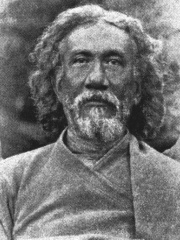
10. Swami Sri Yukteswar Giri (1855 - 1936)
With an HPI of 69.76, Swami Sri Yukteswar Giri is the 10th most famous Indian Religious Figure. His biography has been translated into 26 different languages.
Swami Sri Yukteswar Giri (also written Sriyuktesvara, Sri Yukteshwar) (Devanagari: श्रीयुक्तेश्वर गिरि) (10 May 1855 – 9 March 1936) is the monastic name of Priya Nath Karar (also spelled as Priya Nath Karada and Preonath Karar), an Indian monk and yogi, and the guru of Paramahansa Yogananda and Swami Satyananda Giri. Born in Serampore, West Bengal, Sri Yukteswar was a Kriya yogi, a Jyotishi (Vedic astrologer), a scholar of the Bhagavad Gita and the Upanishads, an educator, author, and astronomer. He was a disciple of Lahiri Mahasaya of Varanasi and a member of the Giri branch of the Swami order. As a guru, he had two ashrams, one in Serampore and another in Puri, Odisha, between which he alternated his residence throughout the year as he trained disciples. Described by Tibetologist W.Y. Evans-Wentz as being "of gentle mien and voice, of pleasing presence," and with "high character and holiness," Sri Yukteswar was a progressive-minded figure in 19th-century Serampore society; he regularly held religious festivals throughout the year around the towns and at his ashrams, created a "Satsanga Sabha" spiritual study organisation, established syllabi for educational institutions, and re-analysed the Vedic astrological yugas. Noted for his sharp mind and insightful knowledge, he became a respected guru throughout the greater Kolkata area to his Kriya yoga students, and also regularly invited individuals from all social backgrounds to his ashrams to discuss and exchange ideas on a range of topics. As a guru, he was nonetheless known for his candid insight, stern nature and strict disciplinary training methods, as noted by his disciple Yogananda in his autobiography. The rigorous nature of his training eventually prepared his disciples, such as Satyananda and Yogananda himself, for their own intense social work in India and America, respectively. In accordance with the high ideals and "penetrating insight" with which he lived, Sri Yukteswar was considered by Yogananda as a Jnanavatar, or "Incarnation of Wisdom;" Evans-Wentz felt him "worthy of the veneration which his followers spontaneously accorded to him...Content to remain afar from the multitude, he gave himself unreservedly and in tranquility to that ideal life which Paramhansa Yogananda, his disciple, has now described for the ages."
People
Pantheon has 64 people classified as Indian religious figures born between 872 BC and 1973. Of these 64, 13 (20.31%) of them are still alive today. The most famous living Indian religious figures include Radha, Ravi Shankar, and George Alencherry. The most famous deceased Indian religious figures include Mahavira, Ānanda, and A. C. Bhaktivedanta Swami Prabhupada. As of April 2024, 2 new Indian religious figures have been added to Pantheon including Anthony Poola, and George Koovakad.
Living Indian Religious Figures
Go to all RankingsRadha
HPI: 69.21
Ravi Shankar
1956 - Present
HPI: 67.60
George Alencherry
1945 - Present
HPI: 67.56
Mata Amritanandamayi
1953 - Present
HPI: 67.10
Mahavatar Babaji
1900 - Present
HPI: 66.55
Joseph Coutts
1945 - Present
HPI: 63.30
Zakir Naik
1965 - Present
HPI: 62.35
Filipe Neri Ferrão
1953 - Present
HPI: 60.42
Oswald Gracias
1944 - Present
HPI: 59.52
Baselios Cleemis
1959 - Present
HPI: 57.28
Mohan Bhagwat
1950 - Present
HPI: 53.27
Anthony Poola
1961 - Present
HPI: 51.01
Deceased Indian Religious Figures
Go to all RankingsMahavira
599 BC - 527 BC
HPI: 81.77
Ānanda
600 BC - 500 BC
HPI: 78.77
A. C. Bhaktivedanta Swami Prabhupada
1896 - 1977
HPI: 77.86
Sathya Sai Baba
1926 - 2011
HPI: 75.23
Guru Gobind Singh
1666 - 1708
HPI: 73.68
Maudgalyayana
568 BC - 484 BC
HPI: 71.51
Mahākāśyapa
550 BC - 549 BC
HPI: 71.13
Dayananda Saraswati
1824 - 1883
HPI: 70.37
Chaitanya Mahaprabhu
1486 - 1534
HPI: 70.26
Swami Sri Yukteswar Giri
1855 - 1936
HPI: 69.76
Mirza Ghulam Ahmad
1835 - 1908
HPI: 69.56
Mahinda
285 BC - 205 BC
HPI: 69.02
Newly Added Indian Religious Figures (2025)
Go to all RankingsOverlapping Lives
Which Religious Figures were alive at the same time? This visualization shows the lifespans of the 25 most globally memorable Religious Figures since 1700.

